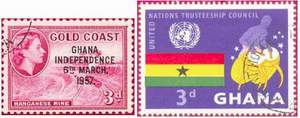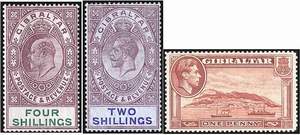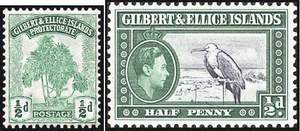GERMANY — philatelic title brands Germany 1900-20 years with a symbolic image of Germany.
GERMANY — philatelic title brands Germany 1900-20 years with a symbolic image of Germany.
GHADAMES EDITION [Ghadames, Libya]. In 1943 the city of Ghadames was occupied by French troops. Was part of the territory of the Fezzan. Since 1951 part of Libya. In 1949 issued its own stamps with the inscription (in French) "Military territory of Ghadames". Since 1951 are in circulation stamps of Libya.
GHANA [Ghana], Republic of Ghana — gosudarstvovo in West Africa. Until 1957 the British colony called Gold Coast. Independence proclaimed 06.03.1957. Republic 01.07.1960. The first stamps (1957) — a commemorative in honor of independence. At the same time on standard stamps of the Gold Coast made overprint (English) "Ghana. Independence. On 6 March 1957". The first unit came into circulation in 1959, the first postal airmail stamps — 1959. The proclamation of the Republic marked a memorable series and a block. Since 1964, most brands were manufactured without teeth, which in the post are sold.

Postage stamps of Ghana
GIBBONS CATALOGUE — first published in Stanley Gibbons in 1865 in Plymouth catalogue of postage stamps. Since 1879 annually in London in English as a universal catalogue of stamps of the world. Has 2 options: so-called "Grand Gibbon" of the 22 volumes (stamps of great Britain and British Commonwealth countries, stamps of European countries and their former colonies, stamps of other countries of the world); simplified catalogue covering the stamps of all countries of the world. In 1984, a catalogue of the "Birds" began production of the motif directory.
GIBRALTAR [Gibraltar] — the area to the South of the Iberian Peninsula, the British possession. The first stamps issued in 1886 — brand Bermuda virgin Islands (British) "Gibraltar". At the end of 1886 entered into circulation stamps with a portrait of the Queen and of the area. The first commemorative stamp issued in 1931. Since 1969 some marks on the reverse side of the printed explanation of the drawings. In 1974, the first block and mark in booklets. The number of stamps issued in mini sheets of 6 or 10 stamps. Stamps war tax, published in 1918 stamps, postage due stamps were issued in 1956.

Postage stamps of Gibraltar
GILBERT AND Ellice ISLANDS [Gilbert and Ellice Islands] — since 1916 the British colony in the Western Pacific including the Phoenix Islands, Washington, Christmas (since 1919), Fanny and others. Under the British protectorate since 1892. 01.01.1976 colony is divided into two parts — Gilbert Islands and Tuvalu (Ellis island). 12.07.1979 Gilbert Islands became the independent state of Kiribati. With 01.10.1978 Tuvalu is an independent state. The first stamp issued in 1911 overprint the name of the protectorate on stamps of the Fiji Islands. In 1918, used postal tax stamp. Since 1935, was issued commemorative stamps in 1974 released the first block, in 1940 — postage due stamps. The issuance of stamps for the Gilbert Islands continued until 1979.

Postage stamps of Gilbert and Ellice Islands
GLAUCHAU PROVISORY [Glauchau, the Soviet zone of occupation of Germany, now part of Germany]. In June 1945, entered into circulation a postage and service stamps of Germany overprinted with the (German) "District Glauchau" and partially new value. Prepared in August 1945, the series, with overprint of the city's coat of arms in the letter. Also known test specimens.
GLAZUNOVKI PROVISORY (Orel province) — the local issue of 1920, the revaluation of plying brands in the ratio 1:100,— handwritten in purple ink new denominations on stamps of Russia: "RUB 2" on the stamp 2 COP., "$ 5" by 5 kopecks, "10 RUB." 10 kopecks.
GLUE:
1. Water-soluble adhesive of different origin and composition. Applied in the production process on the reverse side of stamps. Composition distinguish animal Glue (gelatin, bone, fish), vegetable (gum Arabic, dextrin) origin and synthetic.
2. In philately the word Glue for brevity, denote the adhesive layer on the reverse side of stamps. The process of applying the adhesive layer is called gumming. Sometimes after applying the adhesive, it is subjected to the corrugation (see Glue corrugated). In recent years, to prevent (reduce) warpage is slab is used in breaking the adhesive. In some countries with hot climates (China, Vietnam) a number of brands are produced without glue. The adhesive layer may be smooth, glossy or matte, grainy. The glue can vary from thin white, almost invisible on paper, rough yellow, light brown, brown, granular — applied unevenly. Common Glue: an economical, tropical, tinted, flavored, dry, brittle, hygroscopic, nesasanai and so on.
GLUE BONE (FISH) — glue some stamps from the classical period, characterized by a special durability. Does not dissolve in a water bath and is removed with great difficulty. At the same time removing the glue from the stamps are often necessary, because of the time he cracks that may lead to the rupture of the paper. Removing the glue requires special care, patience and skill.
COLORED GLUE — see Adhesive tinted.
GLUE PATTERNED — adhesive layer is subjected to poluzatonuvshy able machining on special machines, "hacking" adhesive coating. It is used to prevent (reduce) warpage sheets and stamps. In relation to the figure of the brand, the fluting may be horizontal or vertical. In one edition, sometimes there are stamps with Stamps patterned or without him. Used since 1921. It is found on stamps of Germany, France, Czechoslovakia and other countries.
GLUE DRY — philatelic title (not to be confused with brittle glue) adhesives, for example starch or certain types of synthetic adhesive, deep soaking paper. Stamps with the Glue dry sometimes seem to be devoid of adhesive.
GLUE a FAKE — look Glue induced.
INDUCED GLUE — adhesive layer deposited on the stamp (block) for the purpose of restoration of damaged glue or the complete replacement of the washed original glue. Glue induced refers to a partial falsification to the detriment of collectors.
NESASANAI GLUE — see adhesive Stamps.
GLUE the NEW — look Glue induced.
GLUE PAINTED — look Glue tinted.
GLUE the MONOGRAMMED — view of patterned adhesive (with picture), used in 1923 on a 4-stamp series "the Fifth anniversary of the Republic" Czechoslovak post. Using a special form in the glue of stamps imprinted monogram Czechoslovak mail on a background of oblique cells.
Glue the ORIGINAL — stamp the name of the adhesive layer marks printed on the paper in their production and preserved in the future. Damage to the original clean Adhesive stamps sticker, its partial or complete removal and the like sometimes reduces the collectible value of the stamps.